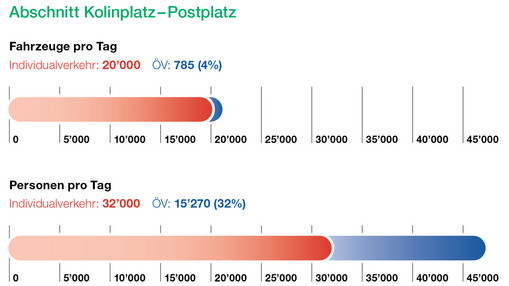This website uses cookies to ensure you get the best experience on our website. By using our website, you agree to our privacy policy and the use of cookies. Learn more.
"Public transport is part of the solution."
The population is growing and mobility is increasing. The ZVB is in favour of the canton's efforts to tackle the issue of mobility as a whole. In this interview, Cyrill Weber, CEO of ZVB, explains what contribution ZVB can make to the mobility solution and what resources it needs to do so.
Zug is the canton with the highest car density and high public transport subscription penetration. What does this show?
Cyrill Weber: The people of Zug live the transport mix. We need this mix - from cars and public transport to cycling and pedestrian traffic - in order to be able to meet mobility needs in the future. The key question is how we allocate the available space to the various modes of transport and thus control the mix. Public transport has an unbeatable advantage here: we transport many people in a small space. Transport space that is only available to a limited extent. Public transport is a space-saving form of mobility.
Public transport therefore plays a decisive role in reducing congestion and relieving congestion on the roads.
That is correct. This is particularly clear in the city centre. Around 20,800 vehicles a day travel between Kolinplatz and Postplatz. Of these, 4% are public transport vehicles, but they carry 32% of the passengers. It is easy to imagine what would happen if some of these people were to switch to cars.

On one day, 20,000 private vehicles and 785 ZVB buses travel on the Kolinplatz-Postplatz section. These transport 32% of the passengers.
The ZVB buses are also sometimes stuck in traffic jams.
This is an important issue. Punctual, reliable public transport is extremely important. Passengers should reach their destination on time and connections must be guaranteed. If the ZVB is stuck in traffic jams, we cannot fulfil this task. However, customers must be able to rely on public transport so that it can make its contribution to overall mobility and provide its benefits. It therefore needs certain framework conditions.
What framework conditions does the ZVB need?
There are various solutions to ensure timetable stability. Prioritisation at traffic lights is a simple measure. A separate bus lane for sections with high traffic volumes is a more far-reaching measure, although this does not necessarily have to be a structural solution, but can also be solved operationally by prioritisation. Riding in the flowing mass of cars can be a solution if the appropriate prioritisation is in place at junctions and stops. It should also be considered whether all modes of transport need to travel on the same road. If they all travel on the same axis, there must be a correspondingly large road cross-section. Separating high-speed and low-speed modes of transport makes traffic flow more smoothly and therefore more effectively. Public transport also benefits from this, as it can run more reliably. These are just a few examples. All our endeavours are always aimed at providing safe, reliable and high-quality public transport that brings many benefits.
What do you mean by quality in public transport?
In addition to punctuality and timetable stability - which is becoming increasingly difficult to maintain - it's about offering passengers the most pleasant journey possible. I'm thinking here of obstacle-free bus stops, pleasant waiting areas, information systems of a high standard and, fundamentally, good public transport accessibility. It goes without saying that I consider it desirable for public transport to be fuelled by renewable energies.
However, quality also means that new forms of multimodal mobility are offered, such as the combination of public transport and bike sharing or on-demand services. New forms will certainly be added and development is progressing rapidly. The digital and spatial networking of the various existing and new forms is important and must be orchestrated. We also see this as a contribution by the ZVB. After all, the various measures will increase Zug's attractiveness as a location.

"It seems important to me that there is a clear strategy for mobility development and that public transport is given the infrastructure and framework conditions it needs to fulfil its mission."
Cyrill Weber, Head of Zugerland Verkehrsbetriebe.
What is your wish for politicians?
Whatever measures are implemented in the end: It seems important to me that, on the one hand, there is a clear strategy as to how mobility should be organised and, on the other hand, that public transport is given the infrastructure and framework conditions it needs for its mission. I have already described some of the measures. Public transport must be considered and planned for in good time. The best solution must be found in order to be able to offer high-quality public transport.
Further links:
ZVB position on the mobility concept for Canton ZG
Space-saving mobility - what is it?
Traffic management canton Aargau
"We are optimising traffic"- Interview with Daniel Schwerzmann

